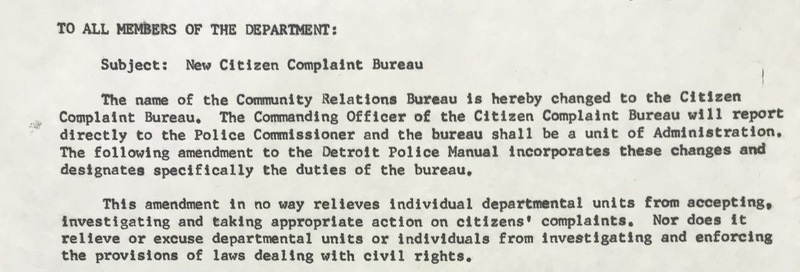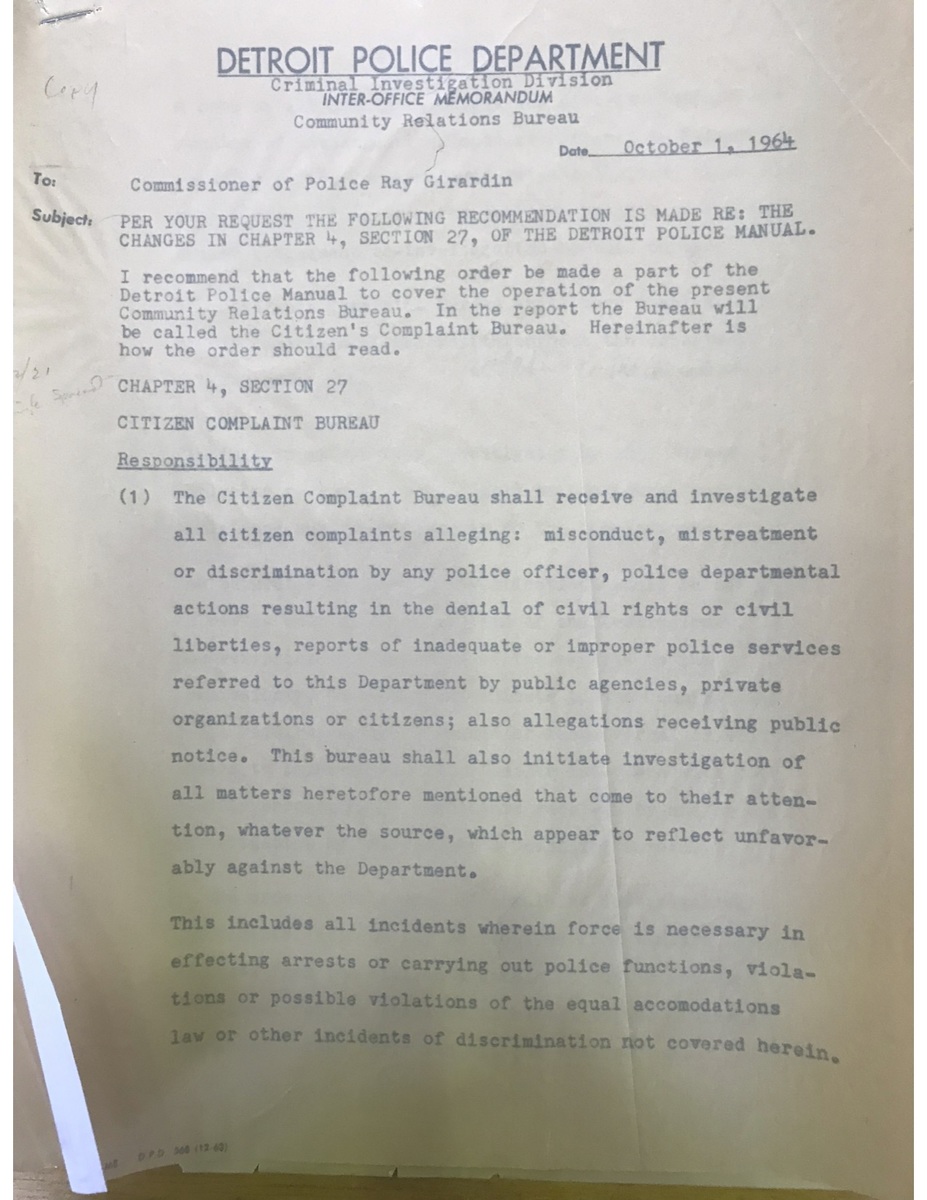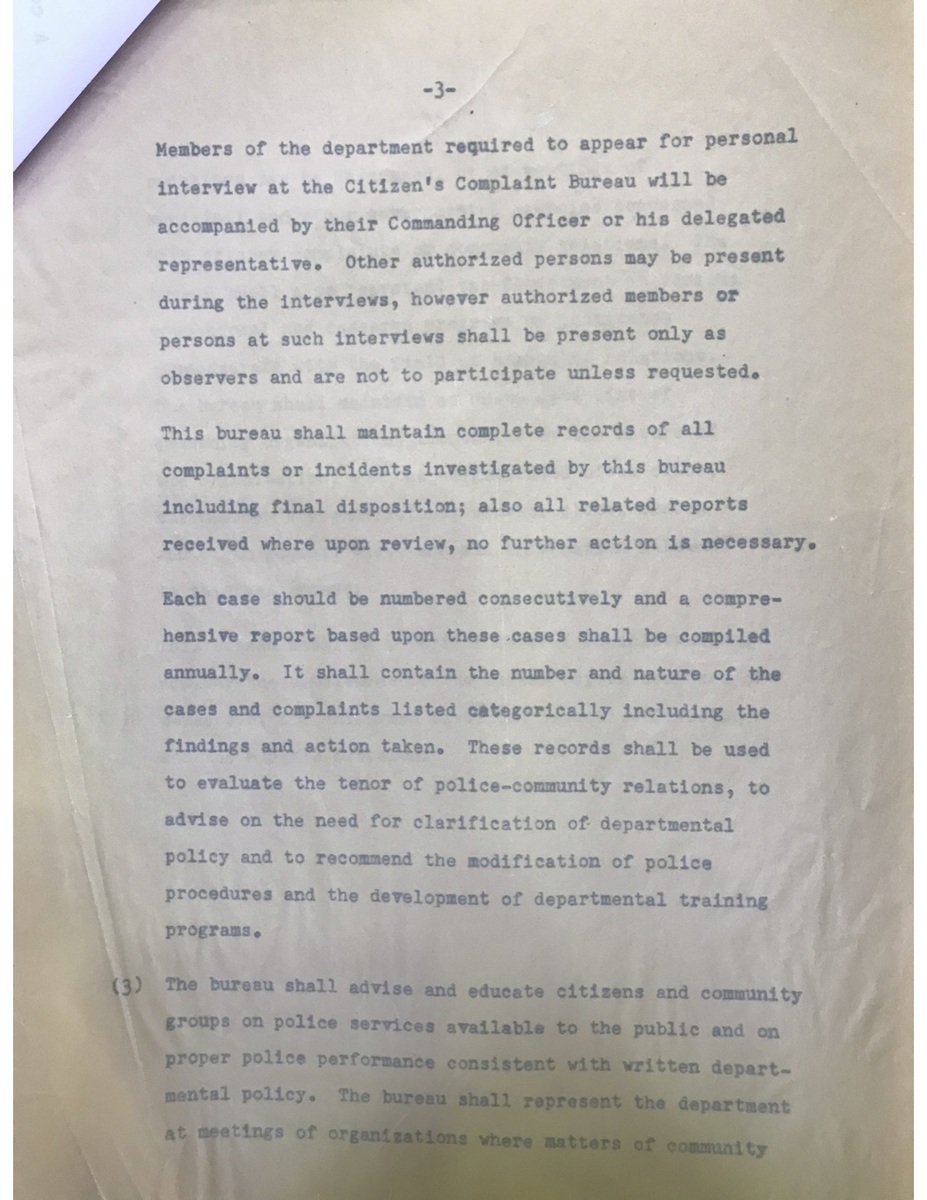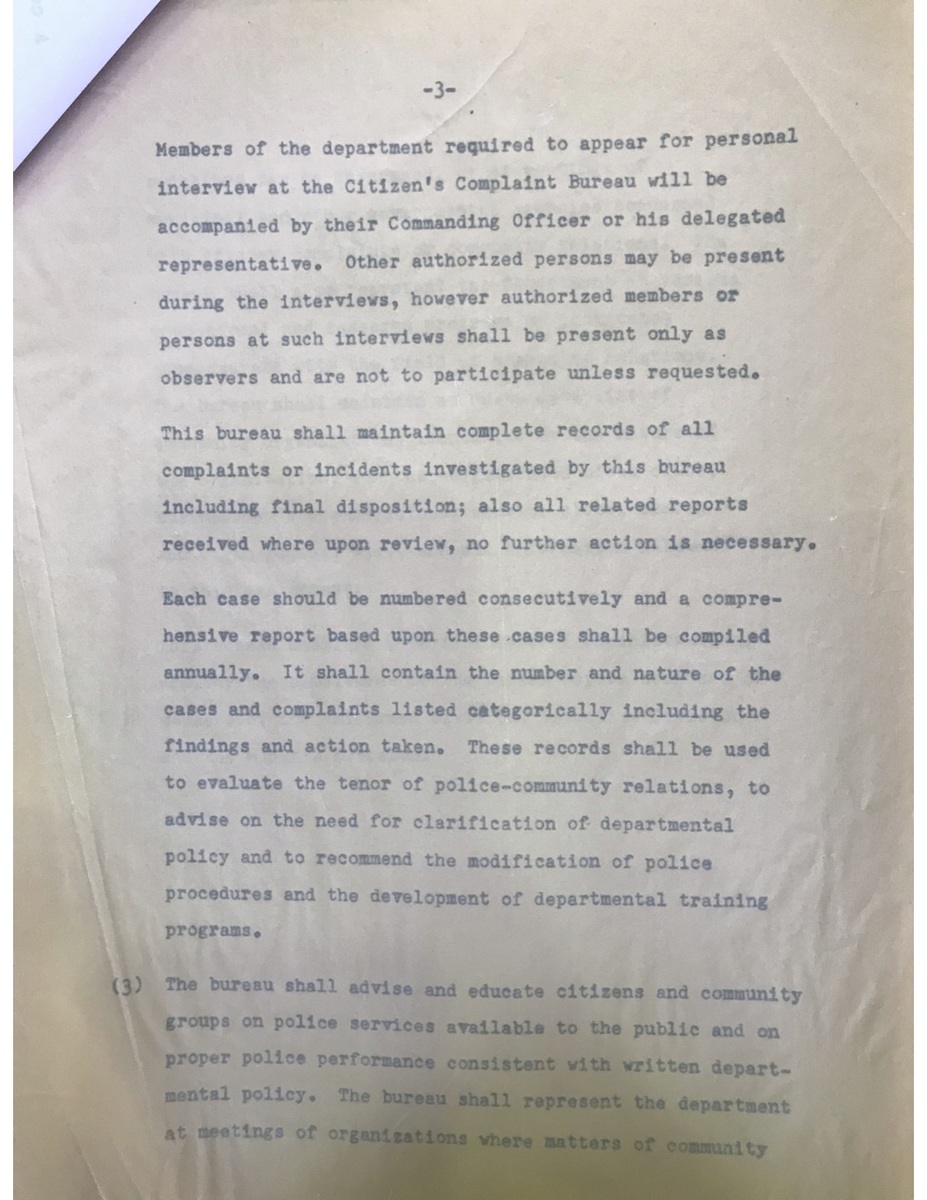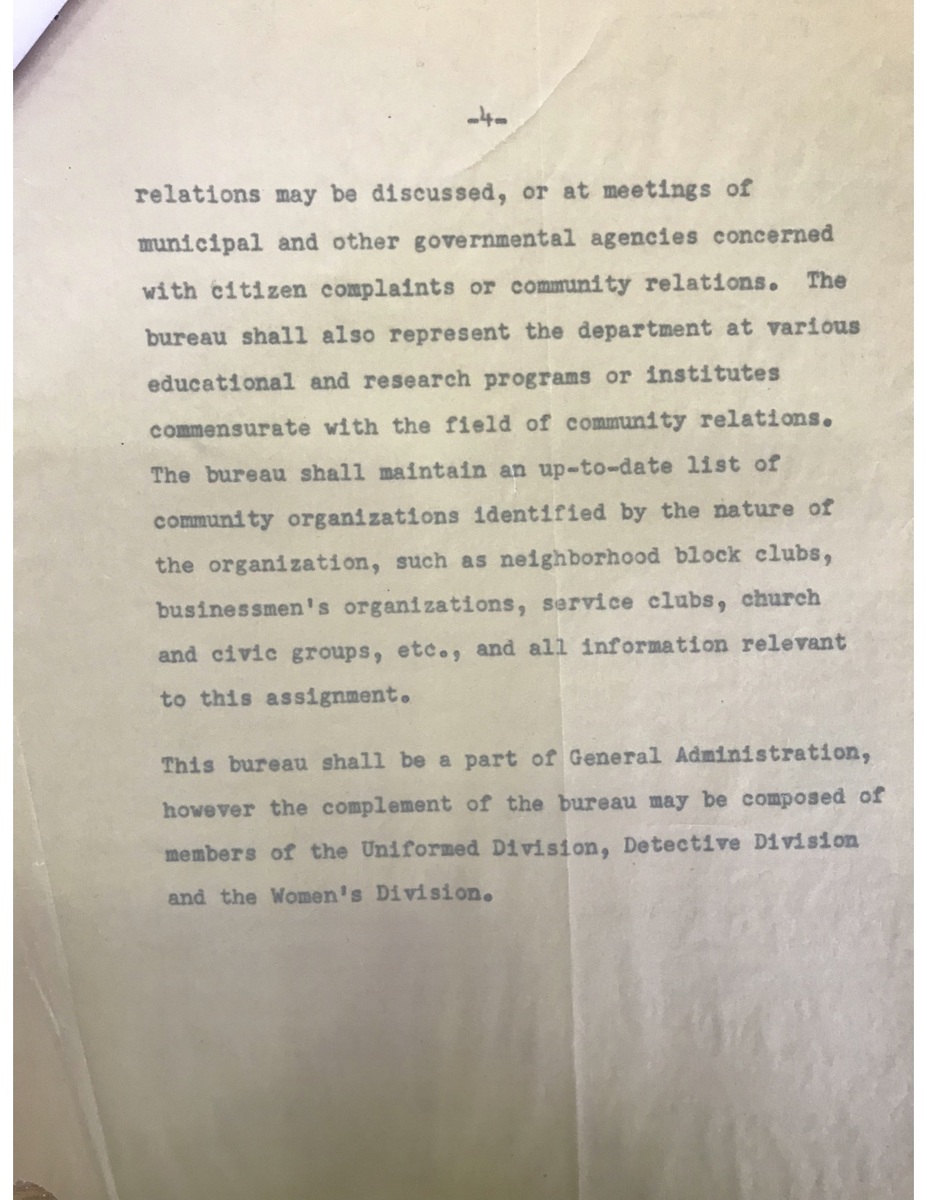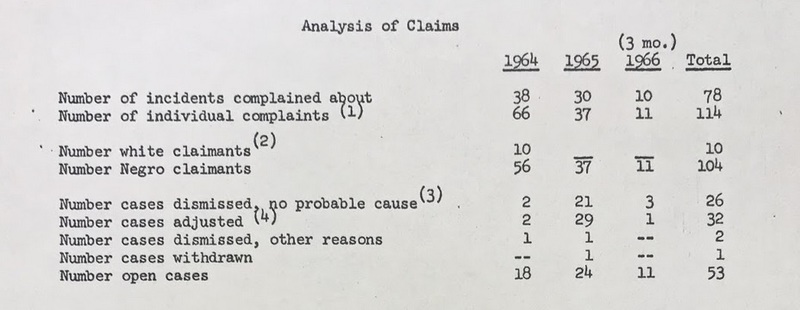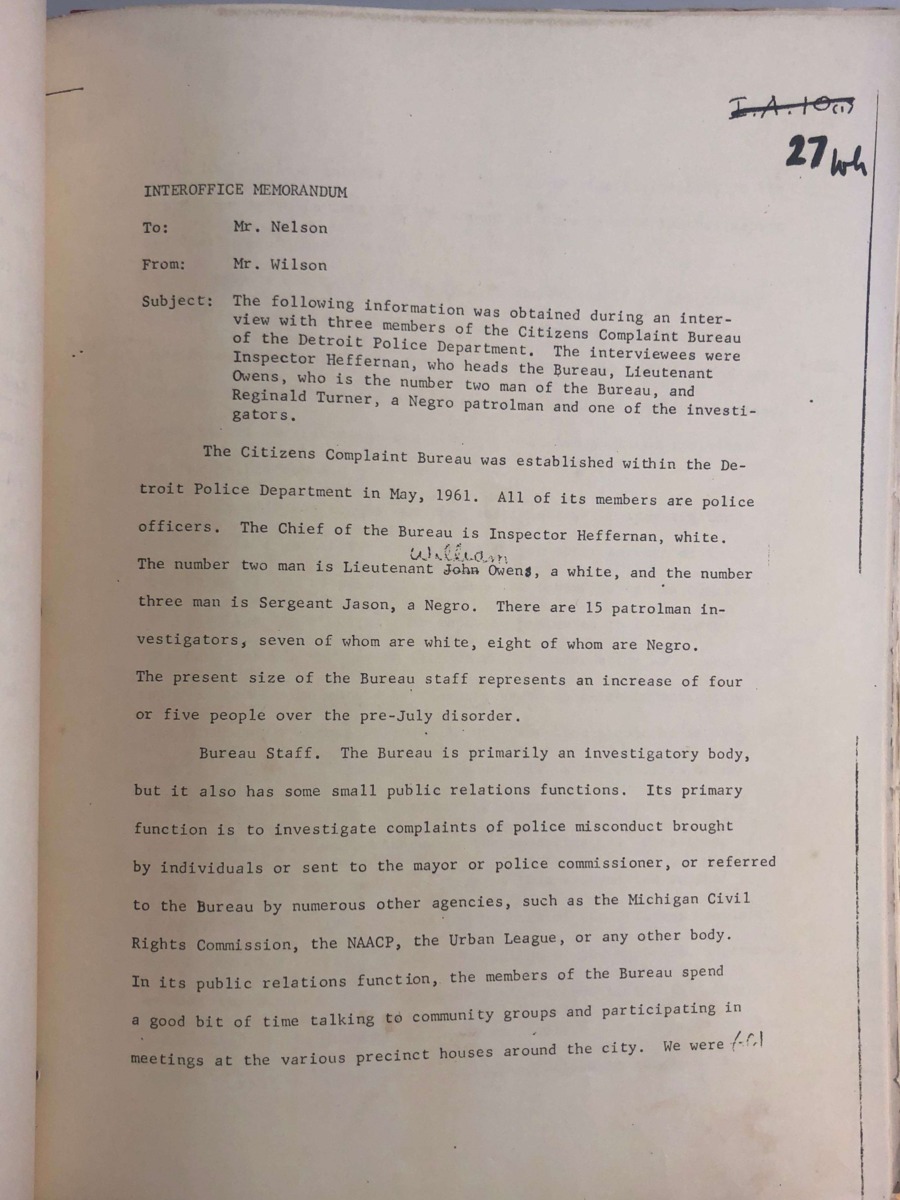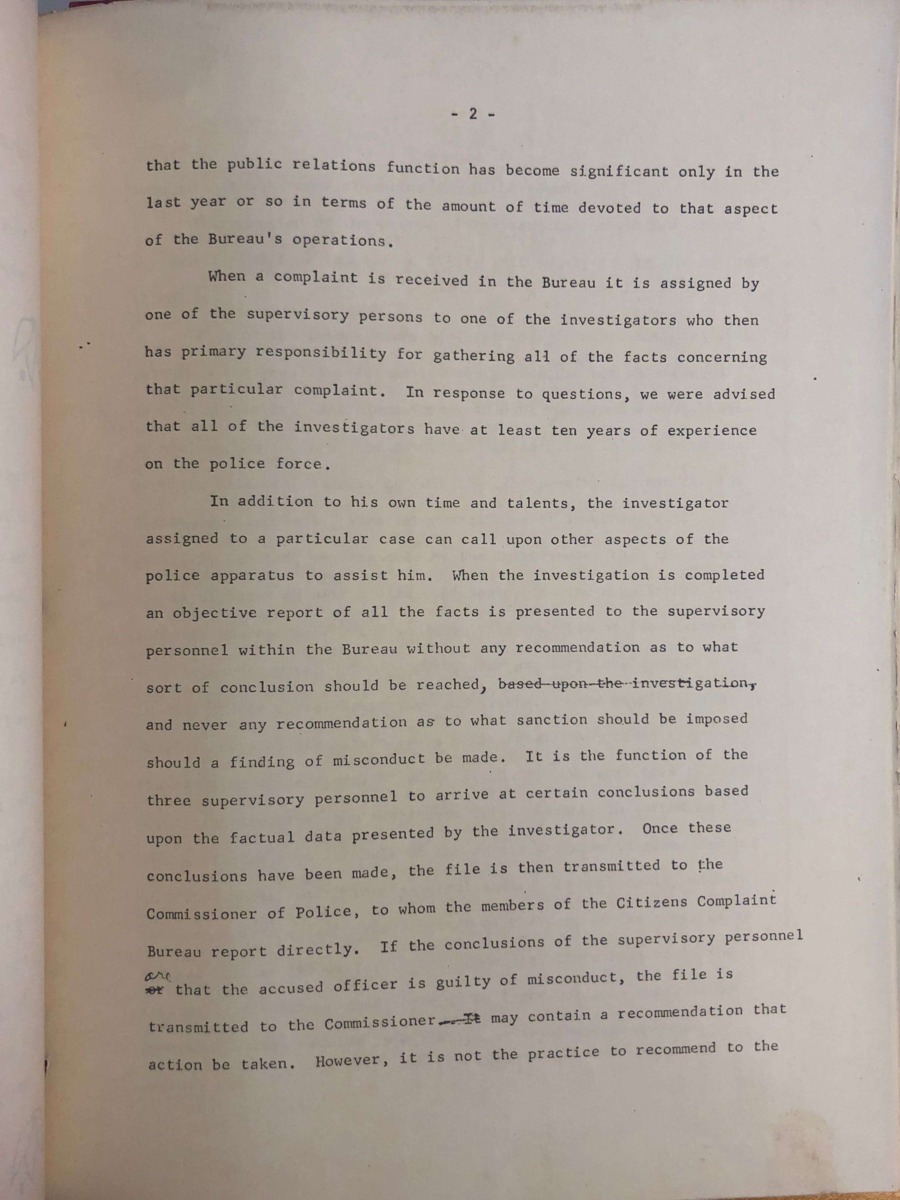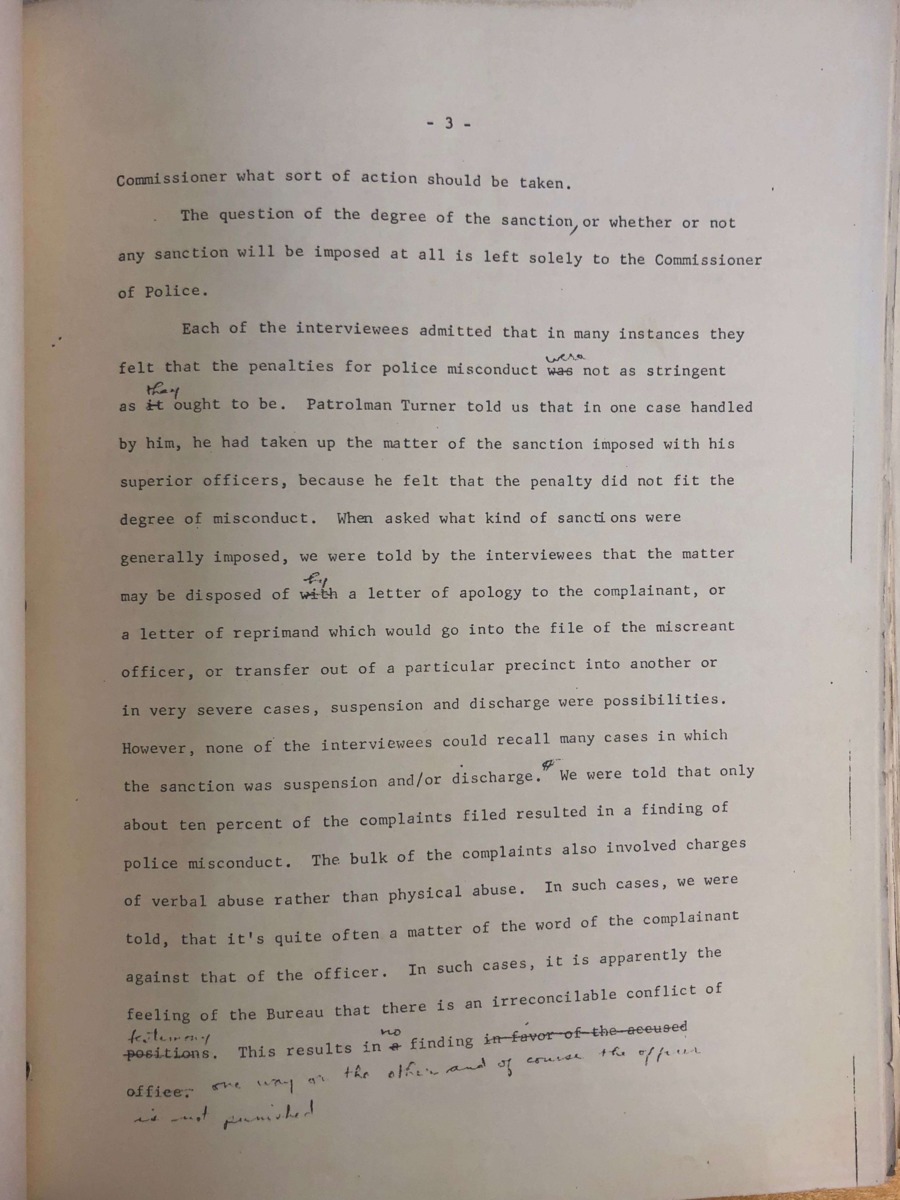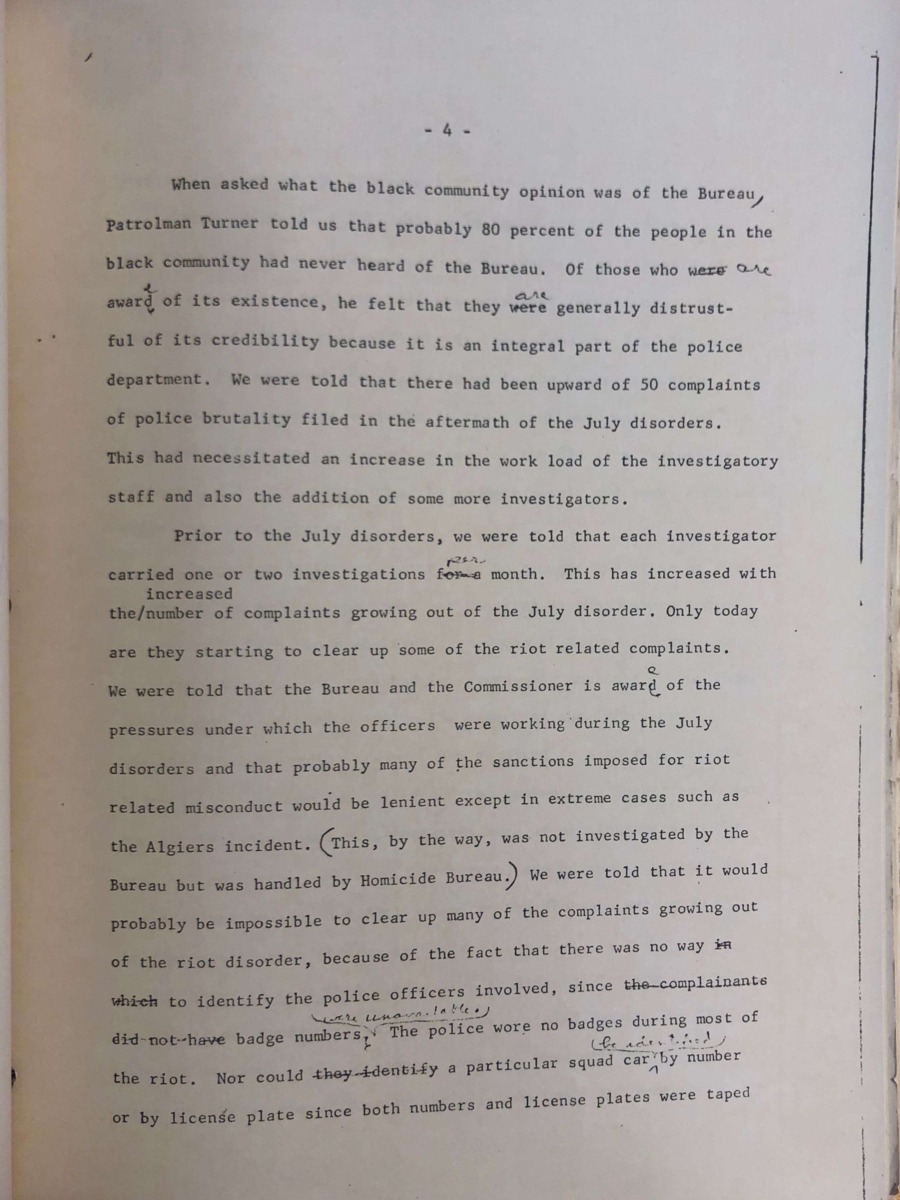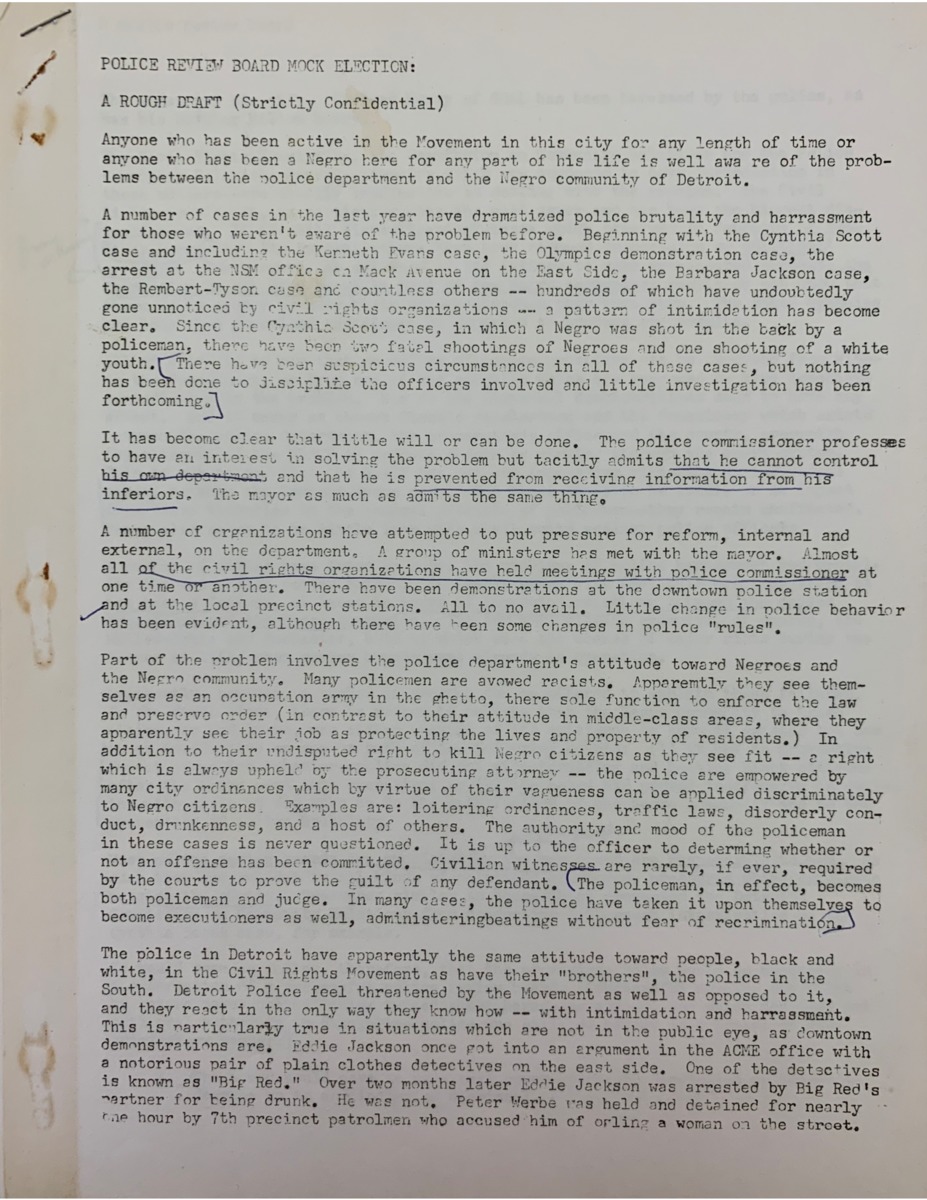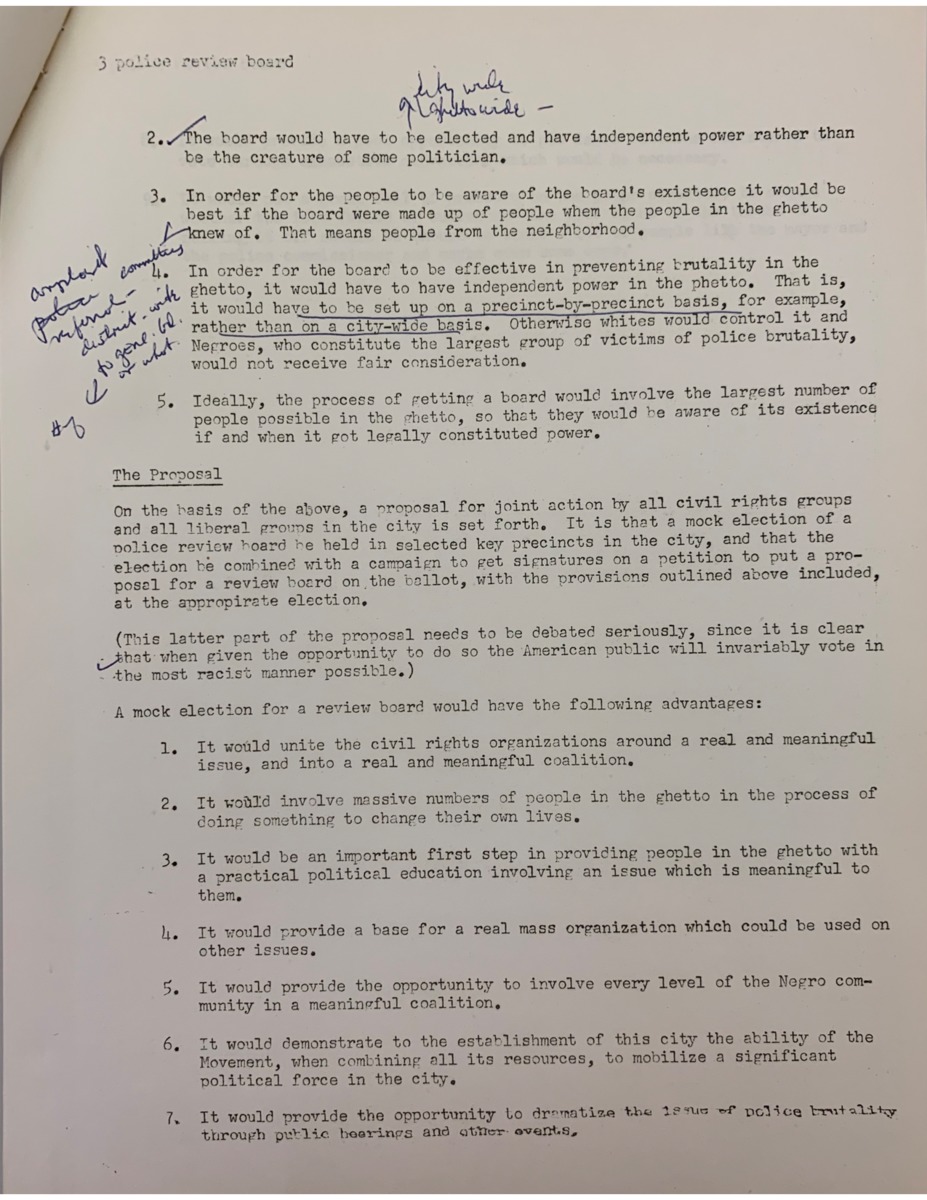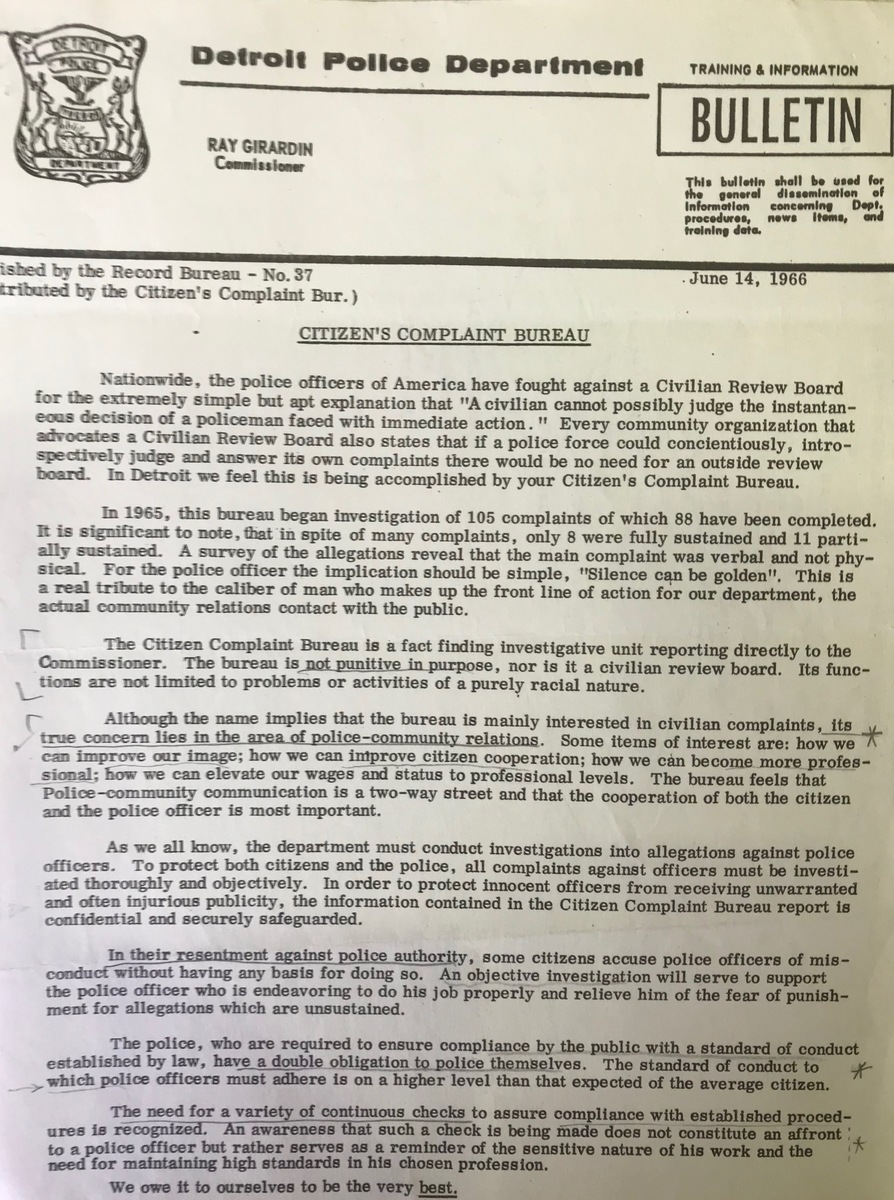Citizen Complaint Bureau
In 1964, the NAACP proposed a series of recommendations to the Detroit Police Department with the hope of improving police-community relations. The proposal included six suggestions specifically targeting reform of the Community Relations Bureau. The NAACP requested that the police commissioner be more involved in the investigative process of complaints, and in addition, that the public have increased knowledge about and say in the process. Shortly after, Commissioner Ray Girardin signed an order that implemented changes to the ways in which the DPD received and reviewed civilian complaints of police misconduct, brutality and discrimination. Basically, the previous policy that citizens file complaints at the precinct station house of the officer who mistreated them had led to widespread abuses and lack of reliable records, including ignoring of complaints and harassment of the people who filed them, sometimes involving false arrest to coerce them to withdraw the allegation. Reverend Nicholas Hood, who drafted the order that Girardin signed, told the Detroit News that “the changes were in line with proposals by the National Association for the Advancement of Colored People and a biracial committee of clergymen.” The bureau, however, remained confidential and in complete control of the police department, as Girardin refused to adopt the recommendation of a civilian oversight review board, which the NAACP had been calling for since 1958.
One of the major changes that came as a result of the departmental order was the renaming of the Police Community Relations Bureau (CRB) as the Citizen Complaint Bureau (CCB). It is important to emphasize that all members of the CCB were still officers in the Detroit Police Department. Ray Girardin stated that “the name of the bureau was changed because it was often confused with the Commission on Community Relations." Reverend Hood added that “the name change was also designed to point up that the purpose of the bureau was to investigate any citizen complaints against police and not only cases involving minority rights" (the DCCR, an independent agency appointed by the mayor, investigated all forms of racial discrimination including housing, education, and employment as well as policing). The name change to the Citizen Complaint Bureau was part of a new approach intended to appease civil rights groups by committing the DPD to investigate cases of police brutality and discrimination fairly--while continuing to refuse the call for civilian oversight.
The most important reform, in the eyes of civil rights groups, was the declaration that required all complaints and investigative recommendations be submitted directly to the police commissioner, holding Girardin himself accountable. The NAACP believed that if the CCB was required to submit all investigative recommendations to Girardin, then complaints would be taken more seriously and not just covered up at the precinct level. Girardin was argued that the reforms were an “administrative change to increase the efficiency of the department. . . . Communications will go directly from me to the bureau and from the bureau directly to me instead of through channels.” The gallery of documents below are from the Detroit Police Department manual in 1964 and explain the newly implemented policies, including the role of the CCB, the complaint process, and other responsibilities.
A Toothless Reform
The impact of the DPD's policy reform was quite limited. The Citizen Complaint Burau process made it clear that each investigation and all related materials were to remain confidential between the DPD and the complainant, an obstacle to transparency. However, civil rights groups did secure a provision that permitted the Michigan Civil Rights Commission (MCRC) to conduct its own investigations separately. This shift of responsibility did not result in very many police sanctions. An interview with CCB members revealed that “only about ten percent of the complaints filed resulted in a finding of police misconduct.” Of the incidents with a finding of misconduct, “the matter may be disposed of by a letter of apology to the complainant, or a letter of reprimand which would go into the file of the miscreant officer, or transfer out of a particular precinct into another or in very severe cases, suspension and discharge were possibilities. However, none of the interviewees could recall many cases in which the sanction was suspension and/or discharge.” (This interview can be read in full in the gallery below).
A later study of the proceedings of the Citizens Complaint Bureau confirmed that officers almost never received significant punishment, even with clear evidence of criminal misconduct. In 1969, the Detroit Free Press analyzed CCB data and reported that no DPD officer had been dismissed since 1961 and only one had been criminally prosecuted. The CCB investigation cleared police in around 80 percent of the cases, and in the other 15-20 percent where the complaint was sustained, the police commissioner had sole authority to determine punishment. By far, the most common "discipline" handed down by the police commissioner was a verbal warning in a conference that did not become part of the officer's record. On a small number of occasions, the DPD commissioner transferred the officer to another precinct or required a letter of apology to a civilian (these are cases where the officer committed what was clearly felony assault). The DPD almost never convened an internal trial board and never arrested an officer or referred a case to the Wayne County prosecutor. No DPD officer had ever referred a complaint about a fellow officer to the CCB, as every member of the force upheld the so-called "Blue Curtain" of silence.
The lack of police discipline in response to cases of brutality continued to anger civilians and civil rights groups. For example, a 1964 article in the Detroit Courier, an African American newspaper, declared: “Not ‘Buying’ Another Police Whitewash, NAACP Proxy Says.” The article continued: “Another whitewash is how the local NAACP head termed the police department’s handling of an alleged brutality case,” in reference to the brutal police beating of sex worker Barbara Jackson. Overall, the CCB reforms did not work as an effective deterrent to police brutality and misconduct, and tensions between DPD officers and black civilians continued to heighten.
As complaints of police crimes against civilians continued to result in letters of apology or no action at all, civil rights organizations continued to advocate for the creation of a civilian review board to judge cases of misconduct instead of the CCB. Activists and many black civilians alike did not believe that the police should be given the power to dole out punishment to corrupt officers, as the DPD had shown time and again that it could not be trusted to do so fairly. By 1965-1966, the continued pressure from the NAACP and the Northern Student Movement (NSM) resulted in a renewed debate over the creation of a civilian review board. White leaders such as Mayor Cavanagh, Ray Girardin and Wayne County Prosecutor Samuel H. Olsen strongly opposed allowing civilians to have the power to judge the actions of police officers, arguing that they could not understand and should not second-guess the decisions of an officer under pressure. City and DPD leaders also argued that civilian review had been a failure in Philadelphia, where the first such board began. In response, the NSM proposed elections of local community members to the civilian review board, instead of being appointed by the mayor as in Philadelphia. The city of Detroit never agreed to a civilian review board and so distrust of the CCB and the DPD continued to increase, especially in the African American community.
Sources:
Detroit Commission on Community Relations / Human Rights Department Records, Walter P. Reuther Library, Archives of Labor and Urban Affairs, Wayne State University
Detroit Free Press, January 11, 1965
Detroit News, December 22, 1964
William Serrin, "How Well Does the City Police Its Police?" Detroit Free Press, Jan. 24, 1969
Northern Student Movement Records, Schomburg Center for Research in Black Culture, New York Public Library
Sidney Fine Collected Research Materials, Bentley Historical Library, University of Michigan
Detroit Free Press, December 31, 1964



